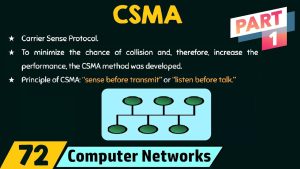CSMA and ALOHA: Aloha differs from CSMA by not checking if the channel is free before sending data, while CSMA verifies it first. Furthermore, Aloha detects busy channels after collisions have already taken place while CSMA works better on networks such as Ethernet where multiple destinations and sources share one channel simultaneously.
Importance of understanding their differences
- Selecting the Appropriate Protocol: Acknowledging the differences between CSMA and ALOHA will enable network administrators or engineers to select the optimal protocol for any particular application or network configuration. Knowing their differences allows you to tailor your network’s performance towards its intended use.
- Increased Network Performance: Network administrators and engineers who understand the differences between CSMA & ALOHA can make informed decisions about how to increase network performance. Based on the needs of their network, they might choose a protocol which reduces latency while optimizing throughput.
- Troubleshooting Network Issues: Recognizing the differences between CSMA & ALOHA can help you quickly identify where network problems stem from when they arise. Collisions could indicate mismatched protocols or incorrect configuration.
- Staying current with technological advancements: As network technologies advance, new techniques and protocols based on CSMA and ALOHA principles emerge. It is vitally important that you are aware of their differences to stay informed on any recent advancements.
CSMA

What Is CSMA ?
Carrier Sense Multiple Access (CSMA) is a network protocol used to control data transmission over shared mediums such as Ethernet. CSMA was designed to prevent collisions among devices in the same network that may cause data loss or congestion, with collisions between packets often leading to data loss or congestion issues.
How CSMA Works:
CSMA is a system in which each device must “listen” on the transmission medium before beginning data transmission. If busy conditions exist on the medium, such as congestion or noise interference, waiting a random amount of time before trying again to transmit is designed to prevent multiple devices from transmitting at the same time and risk collision.
- CSMA protocols offer many advantages: They ensure efficient network resource use by only transmitting data when no other users are present on the network.
- Scalability: CSMA protocol is highly scalable and capable of supporting an increased number of devices connected to the network.
- Flexibility: This protocol can be implemented across various topologies such as bus, star and ring topologies.
- Reliability: CSMA protocols ensure reliable data transmission by limiting collisions among packets.
- Disadvantages of CSMA Latency: Due to device latency, protocols may cause latency as devices must wait a period of random time before sending data.
Limited Network Throughput The CSMA protocol may lead to reduced network throughput if your network is heavily loaded; devices must wait until an available transmission medium has become available before sending their data out for transmission.
ALOHA

What Is ALOHA ?
ALOHA is a shared network protocol developed in the late 1960s by the University of Hawaii to connect computers on Hawaii Island. Devices connected to ALOHA networks can exchange data without checking for network collisions before sending their messages.
How ALOHA Works:
ALOHA allows devices to transmit data at any time without checking whether a transmission medium is active. If there is a collision, devices wait a random amount of time before transmitting again (this is known as “pure ALOH”). Meanwhile, “slotted ALOHA” is an enhanced version that divides time into discrete time slots; devices must transmit at the start of every slot or risk incurring penalties for not doing so.
ALOHA provides many advantages:
- ALOHA is a straightforward protocol designed for easy implementation, making it suitable for low-powered devices or small networks.
- ALOHA supports various network topologies, such as bus, star and ring topologies.
- Low overhead, ALOHA’s overhead costs are minimal as devices don’t need to check for collisions prior to transmitting data.
ALOHA does have some disadvantages:
- Low Efficiency, ALOHA protocol may lead to low efficiency as devices need to wait an arbitrary period before sending information again.
- ALOHA protocol may cause low throughput due to high collision rates.
- ALOHA lacks scalability; it is difficult to avoid collisions in large networks and to ensure reliable data transmission.
Key Differences Between CSMA and ALOHA
- Basic differences in approach and methodology: CSMA and ALOHA differ primarily in how they regulate data packet transmission over a network. ALOHA doesn’t require devices to sense transmission medium before sending data, while CSMA protocols can detect and avoid collisions while ALOHA uses random delays to reduce collision risk.
- Advantages and disadvantages of each protocol: Advantages of the CSMA protocol include efficient network resource utilization, scalability and flexibility; its downsides include latency and complexity. ALOHA protocols are distinguished by their simplicity, flexibility and low overhead costs. Unfortunately, their low efficiency, limited throughput capacity and limited scalability limit their utility and use.
- Compare Performance Metrics: ALOHA protocols offer more efficiency and lower latency due to their ability to avoid collisions; however, CSMA protocols may provide greater efficiency for small networks or devices with low power needs.
- Use cases and real-world applications: CSMA protocols are commonly found in Ethernet networks, Wi Fi networks and many other wireless and wired networking technologies. ALOHA protocols tend to have lower usage in modern networks but may still be utilized by satellite communications providers or low bandwidth radio networks for satellite communications or radio broadcasts. While CSMA works best when networking multiple devices together with multiple bandwidths at once; ALOHA might provide better results in low bandwidth environments with fewer devices present.
Table Differences Between CSMA & ALOHA
| Aspect | CSMA | ALOHA |
|---|---|---|
| Collision Avoidance | Listens to the medium before transmitting data to avoid collisions data to avoid collisions | No collision avoidance mechanism |
| Efficiency | More efficient due to collision avoidance mechanisms and protocols | Less efficient due to potential collisions and retransmissions |
| Persistence | Can use different persistence methods (1-persistent, p-persistent, etc.) | Uses non-persistent transmission, where transmission occurs, immediately after it is requested |
| Scalability | Scales better in large networks | Less scalable, especially in larger networks |
| Backoff | Uses an exponential backoff algorithm | No backoff algorithm |
| Collision Handling | Detects collisions and performs collision detection and recovery | No collision handling or recovery mechanisms |
| Examples | Ethernet (CSMA/CD) Wireless LAN (CSMA/CA) | Original ALOHA, Slotted ALOHA |
What Are The Similarities Between CSMA and ALOHA?
CSMA (Carrier Sense Multiple Access) and ALOHA are two middle access control protocols utilized within computer networks in order to regulate how devices connect and send information over a shared communication channel. Although they differ they have some commonalities:
- Random Access Methods: both CSMA as well as ALOHA can be described as both random access methods. They attempt to transfer data if they have data to transmit without any need for coordination or synchronization.
- Collision Handling: Even though CSMA and ALOHA have distinct collision handling methods both protocols have to deal with collisions that occur. CSMA strives to avoid collisions by sensing the carrier, and ALOHA acknowledges that collisions could occur due to the unpredictable character of the transmission.
- Sharing Channel: Each protocol operates through a shared channel in which several devices compete for the right to transmit information. This shared channel can lead to an opportunity for collisions if multiple devices try to send data simultaneously.
- Simple: Both CSMA and ALOHA provide relatively easy implementations, making them simple to comprehend and use in networks.
- Historical significance: ALOHA was an early concept that laid the foundation for later protocols, like CSMA. CSMA was designed as an improvement on ALOHA by incorporating the concept of carrier sensing in order to decrease the chance of collision. This connection to the past illustrates how the protocols are built upon the same concepts.
- Influence on Influence on Network Design: Both protocols have had an impact on the development of future networking technologies. CSMA and its variants like CSMA/CA has been incorporated into WiFi standards, whereas ALOHA’s principles continue to influence advances regarding medium and random access control methods.
- Flexibility in network size: Both protocols can manage a variety of devices that are connected to the network. The random transmission mechanism of ALOHA allows for various levels of traffic whereas CSMA’s carrier sensing can help to manage the issue of contention as the size of the network increases.
- The first network concepts: Both CSMA and ALOHA were the pioneers of the field of network communication. ALOHA was a fundamental concept that shaped how networks could be able to accommodate multiple devices that share a channel and CSMA added to this by the introduction of carrier sensing in order to improve efficiency.
- Concepts of Collision Avoidance: CSMA as well ALOHA both tackle collisions in different ways. CSMA seeks to prevent collisions by looking for a clear channel prior to transmitting, whereas ALOHA recognizes and handles collisions that could occur during its random transmission method.
Evolution and Adaptations
A. CSMA/CD’s Significance in Ethernet
- Ethernet’s first days in the early days, and the collision domain
- CSMA/CD (Carrier Sense Multiple Access and Collision Detection)
- How CSMA/CD aids in preventing collisions on Ethernet networks
- The transition from half-duplex communications to full-duplex communications
B. Wireless Adaptations of CSMA
- CSMA/CA (Carrier Sensor Multiple Access, with Collision Avoidance)
- The necessity of collision avoidance in a wireless environment
- What is the method by which CSMA/CA deals with hidden terminals and open terminal issues
Wi-Fi Networks and CSMA/CA:
- Use of CSMA/CA within IEEE 802.11 Wi-Fi standard
- The role of Request-to-Send (RTS) and Clear-to Send (CTS) signals
Advanced Variants for Improved Efficiency:
- Enhanced Distributed Channel Access (EDCA) in Wi-Fi
- Prioritizing traffic by using various competing windows
C. ALOHA’s Impact and Influence
ALOHAnet and Early Radio Networks:
- Development of ALOHAnet in the 1970s
- What was the way ALOHA dealt with the problem of having multiple radio users share a radio channel
Basis for Protocol Development:
- The principles of ALOHA laid the groundwork for future protocols
- Element of ALOHA in contemporary network design and optimizing
D. Future Directions in Medium Access Control
Hybrid Approaches:
- Mixing the features of CSMA and ALOHA to create a specialized scenario
Dynamic and Cognitive Access:
- Cognitive radio ideas to make an intelligent selection of channels
- Making access methods more flexible based on circumstances on the network
Impact of 5G and Beyond:
- Integrating CSMA/CA principles into 5G NR-U (New Radio Unlicensed) technology
- Ensuring that wireless spectrum is utilized more efficiently through sophisticated access techniques
E. Continued Research and Innovation
- The ongoing efforts are aimed at optimizing medium access protocols
- Solutions to the challenges of high-density environments as well as IoT networks.
- The balance between fairness, efficiency, and security in the modern network
F. Summary of Evolution
- CMA/CD is the most important element of wireless and wired networks
- The historical significance of ALOHA and its contribution to the development of concepts about networking
- Continuous adaptation and improvement to keep pace with the ever-changing demands of the network communications
Conclusion
Understanding the differences between CSMA & ALOHA when it comes to networking and communication is crucial, since they were among the earliest protocols used for network communication. While CSMA uses sensing technology to avoid collisions, ALOHA uses random delay instead; while CSMA/CD, which utilizes collision detection, makes CSMA more reliable and efficient in networks with high traffic loads. Each protocol offers benefits and drawbacks; which one should be chosen depends upon both your network environment and specific use cases.

